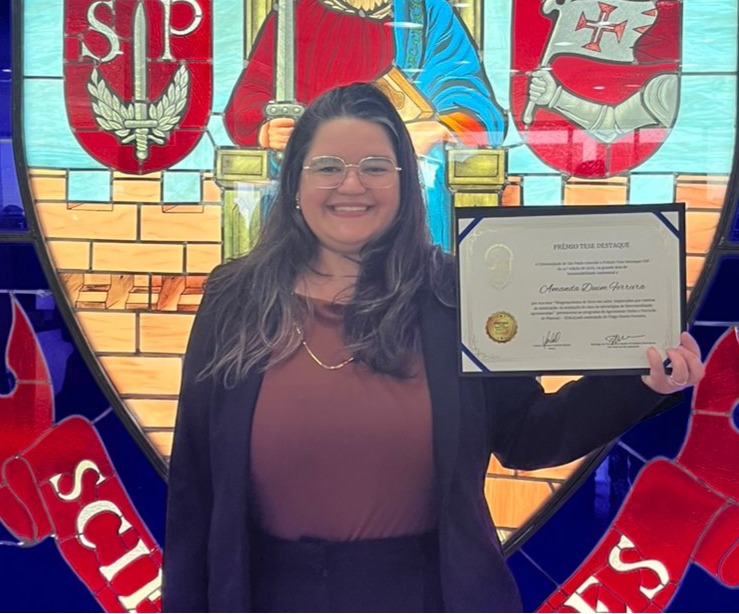How to Unblock Writing? Start from the End
- Amanda Duim Ferreira

- Oct 24
- 6 min read
Who has never frozen in front of a blank Word document? Or spent hours reading and writing only to find, at the end of the day, that none of that content made it into the final draft of your paper? This is much more common than you might think. In this post, Outtadesk lays out a step-by-step approach to help you get unstuck and find the motivation to finish that article, dissertation, or thesis.
The guidance below is based on the author’s professional experience, on lessons learned from wonderful teachers and research partners, and on readings recommended at the end of this text. This “method” is actually a set of practices many experienced scientists already use; we just decided to compile them here.
Remember: there is no one-size-fits-all recipe for success, and there isn’t a single scientific writing method that will work for every researcher. Read, discover, and explore what works for you! In the era of generative artificial intelligence, those who have a distinctive voice and master the craft of writing and storytelling still stand out.
Step-by-step for a new perspective on your manuscript
This step-by-step encourages you to work on your next paper “backwards.” Your path to the first version of the manuscript should follow this order:
Objectives and Hypotheses > Results > Materials & Methods > Discussion > Highlights > Introduction > Abstract > Title > Keywords
Let’s get to work:
Objectives: Let’s start with the main piece of the paper: your objectives. Every research project, dissertation, thesis, or paper begins with a question and an expected answer (a hypothesis). That question must remain crystal clear throughout the writing process. A well-defined objective can save you many (many!) hours when organizing the Results and Methods sections. Write your paper’s objective on paper (or type it in a separate document). Then check it step by step to make it clearer:
Is the sentence longer than three lines? If so, shorten it.
Is the objective specific and well-bounded? Avoid generalities. For example, if you’re working with a plant species, write its name. If you’re testing a new product, specify the active ingredient or the microbial species in the case of biological products.
Is your objective measurable? How will you measure what you propose?
Is there a clear contrast between what’s being tested?
Results: Right after checking objectives, jump straight to the results. Make graphs, figures, and tables; organize them in a logical order; and present them to lab colleagues and/or your advisor. Explore, analyze, and reanalyze the data, check units, calculations, and missing values: this is the time to refine everything that will go into your paper. Separate what belongs to the main narrative (usually 6–8 figures and tables) from what can be moved to the supplementary material. Describe results directly: even if you decide to present Results and Discussion together, the results must come first. Make the necessary comparisons and follow a logical order of presentation.
Materials & Methods: After the Results, take an “active pause” to describe the methods. Writing the Methods becomes much simpler when you’ve already defined the body of the work: you know which results you will present and what belongs to the main story versus the supplement. This part of the writing is more mechanical and gives your brain time to digest the results and think about possible explanations and implications. Describe only the methods related to the results and/or characterization of your study object.
Discussion: After describing the methods, move on to the Discussion, which should start with a short presentation of your results (figures, tables, etc.) to lab colleagues and/or your advisor. Note down every idea, explanation, and implication, and set aside plenty of time for reading and annotating articles. In this phase, you can alternate between reading and writing. If you divide the Discussion into subsections, schedule separate time blocks devoted solely to writing. I strongly recommend recording everything, on paper or in a separate document, every piece of information that seems relevant to your research.
Highlights: After the Discussion, write 3 to 5 highlights. Highlights are short sentences that tell the reader your main findings. Start with longer sentences and progressively shorten them until they fit within 85 characters, including spaces. After the highlights, you can write the conclusion, final considerations, or environmental implications. Don’t repeat the results; the conclusion should speak directly to your objectives. The main role of the conclusion is to state whether your hypotheses were confirmed or not, give a brief explanation why, and, whenever possible, suggest directions for future work.
Introduction: After so much reading and studying for the Discussion, you’ll now have enough knowledge to craft a concise, focused Introduction. Revisit your objective and pick keywords from it, especially those that connect directly with your results. Based on those keywords, structure an Introduction of 5–7 paragraphs (maximum!). The final paragraph should present the rationale (what gap in the literature your work fills), the objective and hypotheses, and a short methodological sentence on how those objectives will be achieved. That methodological sentence should be very short. It only needs to link the Introduction to the next section (i.e., Materials & Methods).
How ready is your paper at this stage? I’d say about 90%.
Now comes the second “active pause.” Reread your paper. Start with typos and formatting: go over the paper with a fine-tooth comb. For example, when numbers are shown, are decimal separators and the number of decimal places standardized? Are scientific names or foreign words italicized? Have all figures and/or tables been cited in the text? Do all figures have clear, informative captions? Is there consistency in the order used to present results? For example, if your graphs/tables compare three different plant species, is the presentation order the same in all figures and tables?
After this first mechanical read, revisit your notes and the comments from your advisor and lab colleagues. Read the paper again with a more critical eye toward content. Assess whether your Results and Discussion support the Objectives and Hypotheses and whether the Conclusions connect to and answer those Objectives and Hypotheses. Also, review whether the highlights are representative and, if necessary, rewrite them to align with the results and conclusions.
Abstract: Now you’re ready to write the abstract. Be concise: open the abstract with an attention-grabbing sentence that leads the reader to agree with your rationale. Describe only the essentials of the methods: sampling or experimental locations, study duration, experimental designs, treatments, number of replicates, etc. Analytical techniques can usually be summarized in one or two sentences — there’s no need for detailed method descriptions. Report the results in the same order they appear in the paper, briefly and, if possible, numerically. Comparisons with percentages or rates of increase/decrease add strength to the abstract. Finish the abstract with a concise overall conclusion and possible implications or follow-ups: future work that should be done, practical applications for communities, policymakers, or other scientists.
Title and Keywords: Only now choose the title and keywords. Avoid titles that are too long (>15–20 words) or simply copies of your objectives. Suggest keywords that complement your title; do not repeat words already in the title.
Congrats, your first draft is ready!
Benefits of this writing model
Here is a list of possible problems that can occur during writing and that can be avoided by following this order for producing the first version of your manuscript:
Prevents overly long Introductions that are misaligned with the results or that give away “the gold” right away.
In storytelling, emotions are used to engage the reader. Scientific writing should be technical; however, that doesn’t mean we can’t appeal to an emotion common to every researcher: curiosity. The Introduction is the right place for that, while also providing the background needed for the reader to understand your hypothesis.
Prevents descriptions of methods that were not actually used.
This error is common when we reuse the project methodology in the paper. Not everything planned in the project was executed, and research plans often change over time to include new techniques or experiments developed during the research process.
Breaks a large task (“write paper XYZ”) into smaller steps.
Reframing big goals into smaller, time-bound subgoals increases task completion. Several studies show increased self-efficacy and reduced procrastination (see the list of consulted articles).
Keeps reasoning aligned between questions (Objectives and Hypotheses) and answers (Results and Discussion).
Writing a paper is telling a story with data, and that story needs a beginning, middle, and end. The curiosity sparked in the Introduction should lead to conclusions aligned with the initial question, and your data are the means to reach those conclusions.
I hope this brief guide helps you to unlock your potential and start to get the work done!
And if you need any help, don't hesitate to check our services at:
Further reading
Schimel, J. (2012). Writing science: how to write papers that get cited and proposals that get funded. OUP USA.
Margulieux, L., Morrison, B., & Decker, A. (2020). Reducing withdrawal and failure rates in introductory programming with subgoal-labeled worked examples. International Journal of STEM Education, 7, 1-16. https://doi.org/10.1186/s40594-020-00222-7.
Rai, A., Sharif, M., Chang, E., Milkman, K., & Duckworth, A. (2022). A field experiment on subgoal framing to boost volunteering: The trade-off between goal granularity and flexibility.. The Journal of Applied Psychology. https://doi.org/10.1037/apl0001040.



Comments